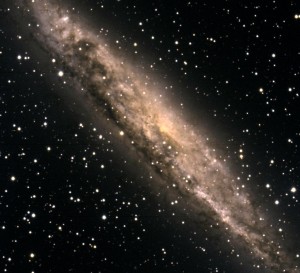
Editor’s Note: For a gallery of images from the telescope, see
http://physics.agnesscott.edu/SARA%20Images/gallery_images.html
TUSCALOOSA, Ala. — Remote access to a telescope in the Andes Mountains of Chile gives a group of astronomers and their students, including those at The University of Alabama, newly acquired peeks into the wonders of the Southern Hemisphere’s nighttime sky.
Astronomers from 10 institutions in six states have banded together, through a consortium called the Southeastern Association for Research in Astronomy, and have just completed refurbishing and automating a 0.6-m telescope at Cerro Tololo Inter-American Observatory in Chile.
“We’ve gained regular access to the half of the sky that never rises in North America,” says Dr. William Keel, professor in UA’s department of physics and astronomy. “Access to this telescope provides us and our students with teaching and research possibilities not previously possible.”
With the help of the Chilean telescope and a telescope the group already operates at Kitt Peak in Arizona, each institution in the group can now view the night skies from both the Northern and Southern Hemispheres (occasionally simultaneously) for about 30 days out of the year.
In order of membership, members of the consortium include Florida Institute of Technology, East Tennessee State University, Valdosta State University, Florida International University, Clemson University, Ball State University, Agnes Scott College, University of Alabama, Valparaiso University and Butler University.
Keel clicked off a number of reasons why access to the Southern sky is important, but virtually missing, for many astronomers.
“The center of our galaxy, the Sun’s nearest stellar neighbors, the nearest radio galaxy powered by a billion-solar-mass black hole, our galaxy’s most powerful regions of starbirth, our brightest companion galaxies, including the site of the closest supernova explosion seen since Galileo turned a telescope skyward, are all seen very poorly, or not at all, from our latitude,” Keel said.
“And there remains an imbalance – not only in where the astronomers are, but where the telescopes are – so the Southern sky remains less well investigated. Thus, there is a strong scientific advantage to having routine access to the entire sky, something relatively few institutions and observatories have managed.”
The consortium, known as SARA, was originally formed in 1992 by Florida Institute of Technology, East Tennessee State University, the University of Georgia (which left the group in 2006) and Valdosta University.
The telescope in Chile was formerly operated by Lowell Observatory in Arizona and was closed by Cerro Tololo in 1996. SARA invested about $250,000 in upgrades to make the telescope remotely accessible over the Internet.
“The 30 astronomy researchers and 10 institutions that make up SARA form a virtual astronomy department that is as large as many major astronomy departments in the U.S.,” said Dr. Terry Oswalt, chairman of SARA and a professor at Florida Institute of Technology.
SARA’s success stems from not only being able to pool their resources, but also to acquire excellent facilities for a very low cost.
“We’re able to benefit from someone else’s investment,” said Keel. “We’ve managed to phenomenally lower operating costs for a telescope of this size,” he said.
For roughly the cost of a few nights of viewing on a very powerful telescope, SARA collaborators instead get about 30 days of time a year. All those extra nights of viewing and the addition of a telescope in the Southern Hemisphere open a host of new opportunities to pursue longer-term projects.
The two SARA telescopes are separated by thousands of miles.
“In the same way having two eyes gives depth perception, the two SARA telescopes give us the ability to measure distances and orbits for such objects as potentially hazardous asteroids,” said Oswalt. “In addition, because they are at different longitudes, they allow us to stay focused on an object for more than the 10 or 12 hours typical of one site.”
Professors and their students can now operate one or both of the telescopes from their university labs on assigned nights, sometimes changing schedules at the last minute to accommodate unexpected opportunities.
“We can easily trade or share nights in real time,” Oswalt said. “If we get what we need, it’s not unusual for us to call a colleague to take over in the middle of the night. This type of flexibility just isn’t available at more traditional observatories.”
UA’s department of physics and astronomy is part of the College of Arts and Sciences, the University’s largest division and the largest liberal arts college in the state. Students from the College have won numerous national awards including Rhodes Scholarships, Goldwater Scholarships and memberships on the USA Today Academic All American Team.
Contact
Chris Bryant, UA Media Relations, 205/348-8323, cbryant@ur.ua.edu
Source
Dr. William Keel, 205/348-1641, wkeel@bama.ua.edu